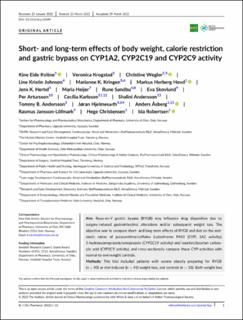| dc.contributor.author | Kvitne, Kine Eide | |
| dc.contributor.author | Krogstad, Veronica | |
| dc.contributor.author | Wegler, Christine | |
| dc.contributor.author | Johnson, Line Kristin | |
| dc.contributor.author | Kringen, Marianne K. | |
| dc.contributor.author | Hovd, Markus Herberg | |
| dc.contributor.author | Hertel, Jens Kristoffer | |
| dc.contributor.author | Heijer, Maria | |
| dc.contributor.author | Sandbu, Rune | |
| dc.contributor.author | Skovlund, Eva | |
| dc.contributor.author | Artursson, Per | |
| dc.contributor.author | Karlsson, Cecilia | |
| dc.contributor.author | Andersson, Shalini | |
| dc.contributor.author | Andersson, Tommy B. | |
| dc.contributor.author | Hjelmesæth, Jøran Sture | |
| dc.contributor.author | Åsberg, Anders | |
| dc.contributor.author | Jansson-Löfmark, Rasmus | |
| dc.contributor.author | Christensen, Hege | |
| dc.contributor.author | Robertsen, Ida | |
| dc.date.accessioned | 2022-11-25T08:58:38Z | |
| dc.date.available | 2022-11-25T08:58:38Z | |
| dc.date.created | 2022-04-19T15:05:42Z | |
| dc.date.issued | 2022 | |
| dc.identifier.issn | 0306-5251 | |
| dc.identifier.uri | https://hdl.handle.net/11250/3034032 | |
| dc.description.abstract | Aim
Roux-en-Y gastric bypass (RYGB) may influence drug disposition due to surgery-induced gastrointestinal alterations and/or subsequent weight loss. The objective was to compare short- and long-term effects of RYGB and diet on the metabolic ratios of paraxanthine/caffeine (cytochrome P450 [CYP] 1A2 activity), 5-hydroxyomeprazole/omeprazole (CYP2C19 activity) and losartan/losartan carboxylic acid (CYP2C9 activity), and cross-sectionally compare these CYP-activities with normal-to-overweight controls.
Methods
This trial included patients with severe obesity preparing for RYGB (n = 40) or diet-induced (n = 41) weight loss, and controls (n = 18). Both weight loss groups underwent a 3-week low-energy diet (<1200 kcal/day, weeks 0-3) followed by a 6-week very-low-energy diet or RYGB (both <800 kcal/day, weeks 3-9). Follow-up time was 2 years, with four pharmacokinetic investigations.
Results
Mean ± SD weight loss from baseline was similar in the RYGB-group (13 ± 2.4%) and the diet group (10.5 ± 3.9%) at week 9, but differed at year 2 (RYGB −30 ± 6.9%, diet −3.1 ± 6.3%). From weeks 0 to 3, mean (95% confidence interval [CI]) CYP2C19 activity similarly increased in both groups (RYGB 43% [16, 55], diet 48% [22, 60]). Mean CYP2C19 activity increased by 30% (2.6, 43) after RYGB (weeks 3-9), but not in the diet-group (between-group difference −0.30 [−0.63, 0.03]). CYP2C19 activity remained elevated in the RYGB group at year 2. Baseline CYP2C19 activity was 2.7-fold higher in controls compared with patients with obesity, whereas no difference was observed in CYP1A2 and CYP2C9 activities.
Conclusion
Our findings suggest that CYP2C19 activity is lower in patients with obesity and increases following weight loss. This may be clinically relevant for drug dosing. No clinically significant effect on CYP1A2 and CYP2C9 activities was observed. | en_US |
| dc.language.iso | eng | en_US |
| dc.publisher | British Pharmacological Society | en_US |
| dc.rights | Attribution-NonCommercial-NoDerivatives 4.0 Internasjonal | * |
| dc.rights.uri | http://creativecommons.org/licenses/by-nc-nd/4.0/deed.no | * |
| dc.title | Short- and long-term effects of body weight, calorie restriction and gastric bypass on CYP1A2, CYP2C19 and CYP2C9 activity | en_US |
| dc.title.alternative | Short- and long-term effects of body weight, calorie restriction and gastric bypass on CYP1A2, CYP2C19 and CYP2C9 activity | en_US |
| dc.type | Peer reviewed | en_US |
| dc.type | Journal article | en_US |
| dc.description.version | publishedVersion | en_US |
| dc.source.journal | British Journal of Clinical Pharmacology | en_US |
| dc.identifier.doi | 10.1111/bcp.15349 | |
| dc.identifier.cristin | 2017639 | |
| cristin.ispublished | true | |
| cristin.fulltext | original | |
| cristin.qualitycode | 2 | |

